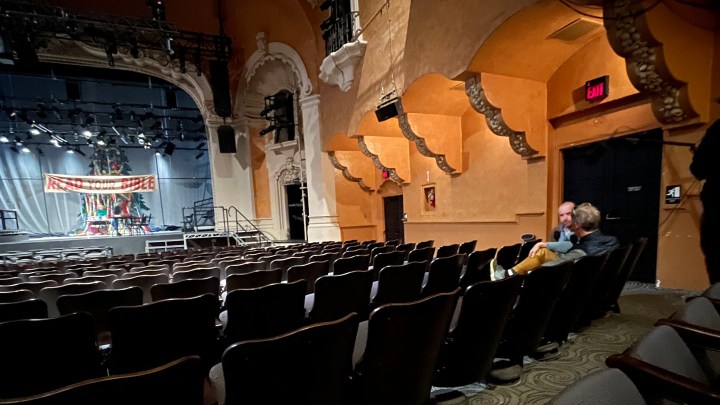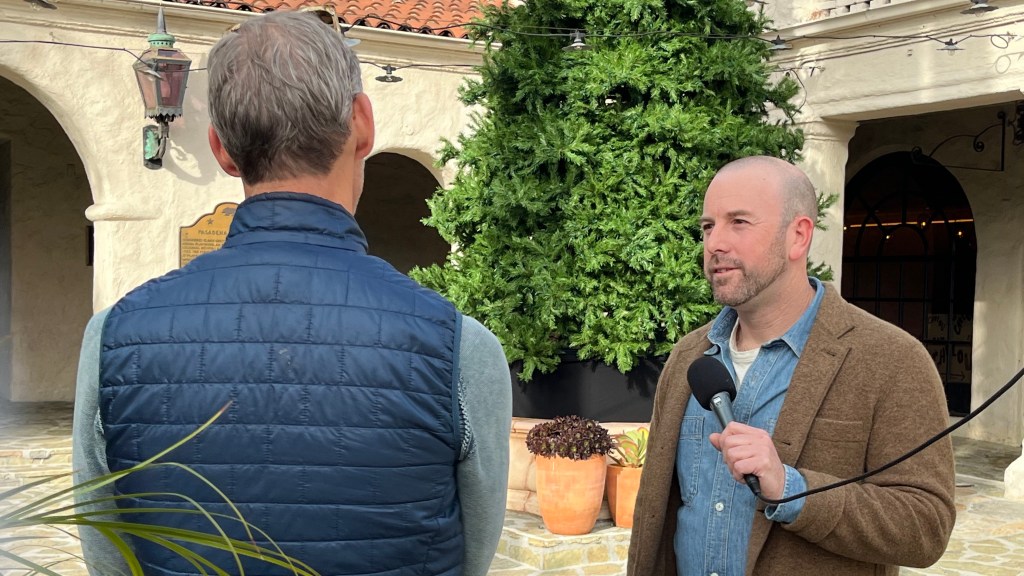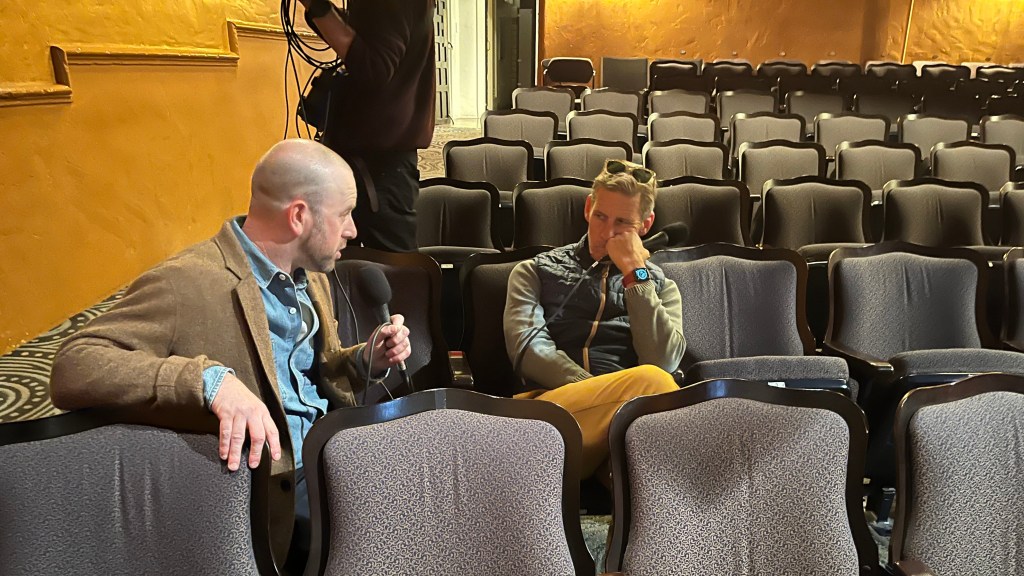
Regional theater is the “engine” behind much of arts and entertainment. It’s also in crisis.
Regional theater is the “engine” behind much of arts and entertainment. It’s also in crisis.

It’s no secret that nonprofit, or regional, theater has struggled to find its footing after the pandemic. Companies around the country are trying to bring audience numbers back to where they were, and, according to Danny Feldman, producing artistic director at the Pasadena Playhouse in California, the regional strains could have effects on a wider scale.
“The research and development that other businesses have, we are the research and development,” said Feldman, who runs one of the oldest regional theaters in the U.S. “[Broadway] shows start in nonprofit theaters all the time.”
The outlook is challenging for the industry. While the Pasadena Playhouse is coming off an award-winning season, other theaters are battling to keep their doors open. A survey from the Theatre Communications Group found that, of 170 theaters surveyed, 55% budgeted in a financial shortfall next year. And nearly 30% described themselves as struggling or worse.
“Marketplace” host Kai Ryssdal visited the Pasadena Playhouse to speak with Feldman about the state of regional theater. The following is an edited transcript of their conversation.
Kai Ryssdal: Full disclosure — I should tell you I come here not all the time, but not infrequently. And it’s great.
Danny Feldman: Thank you.
Ryssdal: I love this place, so there’s my bias going in. But this is not about this place as a physical place. It’s about regional theater.
Feldman: Yes.
Ryssdal: And where you guys stand in the world. So before we go inside, situate us in the world of regional theater in late 2023.

Feldman: So what most folks who just go to the theater, like live entertainment or that, they don’t necessarily know, nor should they, the difference between commercial theater and regional theater. So we mainly think of theater as Broadway, “Hamilton.”
Ryssdal: Interesting. You say “commercial” like it’s a bad thing. And regional —
Feldman: No, it’s not bad. It’s for-profit versus nonprofit. It is New York Times, for-profit journalism, and NPR, public-service journalism, right? Are we serving shareholders? Is our ultimate goal making money or is our ultimate goal public service? The nonprofit regional theater was born out of a response to commercialism, out of a response to Broadway.
Regional theater history
Ryssdal: I should know this. How long has regional theater been a thing?
Feldman: Well, it’s tricky because Pasadena Playhouse is so old — it’s like a terrible joke set-up — but we are so old that theaters and entertainment were not allowed to be nonprofits. That was not put into the nonprofit code, right? It was charities, it wasn’t allowed till much later. Pasadena Playhouse came in the 1920s, really founded in 1917. This building came in the ’20s. But it was founded by a group of Midwesterners who are out here, who said, “Great communities need great culture.” There was not a lot of regional theater. There were tours that would sort of come by, but this [place] was orange groves in 1917, right?
Ryssdal: Right, literally.
Feldman: Yeah, it was, it was a new city by then. And so it was really an innovative and revolutionary thing that happened here, that later would start happening all over the country. And the idea behind the regional theater movement later on in the 1960s was that the individual communities deserved world-class theater, just like Broadway. And so it really started as a reaction to theater artists going back to either their hometowns or going to new towns and saying let’s set up shop here. So it was a very hyperlocal movement about making great art for communities. And that changed over time, but that was really the genesis of it.
An award-winning season
Ryssdal: Let’s go inside. And as we go, here’s the standard opening question. How’s business?
Feldman: You know, we’re an outlier.
Ryssdal: Well, we’re gonna get there.
Feldman: Our businesses is going well, and we’re very unique because …
Ryssdal: So wait, I need you to describe this lobby for me because it’s great. And people should understand what we’re looking at.
Feldman: We are in the lobby, the historic lobby, that was opened in 1925. The very special thing in our lobby right now that you can see is our regional Tony Award.
Ryssdal: I saw. Congratulations.
Feldman: We conveniently placed that.
Ryssdal: I was just gonna say, it’s literally spotlit.
Feldman: Yes, but it’s on purpose because we feel that, that, you know, going into our subject matter, this is this theater’s and this community’s Tony Award. And so we’ve put it right here so people basically trip on it getting into the theater.
Ryssdal: Almost literally.
Feldman: But yes, we’re in the historic lobby that every patron passes through to come see a show and have since 1925.
Post-pandemic theater
Ryssdal: And it’s fabulous. So you were saying you’re doing better than most.
Feldman: We are. And you know, I took over this theater in late 2016. And we were having a rough go, I will say. Not as rough as anyone probably knew publicly. Not as rough, frankly, as I knew coming in.
Ryssdal: Well, I’ll tell you, I mean, those of us who come here knew that it was tricky.
Feldman: It was tricky. And it had been tricky for a while. Our ticket sales were struggling, our donations were struggling. So for us, our story, and I think that’s part of why now we’re at a different place, is we worked very hard digging out and getting community engagement again about this place, so by the time the pandemic hit, we were coming into it in a different spot.
Ryssdal: Well, so that’s a good pause as we head into the house here because I want to sit down. So you’re doing OK-ish as the pandemic hits, and then the pandemic hits. And then what happens?
Feldman: So it was brutal to the theater industry, as you can imagine. A lot of people cut their workforce, we cut our workforce, tremendously. Some theaters as much as 80%. We weren’t quite that high. And I think the bigger challenge, though, looking back now, was as everyone was racing to get the economy going again, to get business going, people don’t want to go to the theater. This was not a thing even with wearing masks, and we still have not recovered. Nationally, the latest figures are between 20% to 50% of pre-pandemic [audiences].
Ryssdal: Really?
Feldman: Yes. Every theater is on a different journey on that. But some theaters have closed. There was a time last year where two to three theaters were closing a month.
Ryssdal: How do you stay in business if you’re at 20-50%?
Feldman: Correct. Well, a lot of what got us through it was the extraordinary government support, the largest government support of the arts in U.S. history, the shuttered venues grant. We were fortunate here at the playhouse to get a couple of very large grants, which were designed to help us get back on our feet. Our argument to the funding community, to our community and to the government was, it is going to take us longer to get back than everyone else. We are going to have to rethink business models. We already were dealing with some real struggles.

Ryssdal: Tell me how you have rethought your business model.
Feldman: Well, for us here, it’s about a couple different directions. We ended the pandemic year, like a lot of businesses did, like a lot of theaters did, with surpluses. Because if you think about it …
Ryssdal: Right, and a lot of families too, actually.
Feldman: We stopped putting shows on, but the money was still coming. A lot of our patrons who had been with us for years said, we’ll let you keep our subscription money, right? We’ll let you keep this, we’re still writing our checks. So our costs dramatically dropped and our revenue actually went up. We made the decision that, rather than storing all of that in the bank, we were going to take a chunk of it, of our saved-up capital, something that this theater has never had ever, ever, ever in our history. We passed a budget last season, which was the big season of our [Stephen] Sondheim celebration, our Tony-winning season, that had a $1 million deficit in the budget. Why? Because we had a $3 million surplus the year before. We hired more artists than we’ve ever hired that year. We hired more musicians, we hired more crew. It was the most ambitious thing we’d ever done.
Ryssdal: So I came to see “Sunday in the Park with George” here. I still don’t understand the second act of that thing. I don’t understand it for the life of me.
Feldman: Right. I can explain it to you.
Ryssdal: The first act, I was on board, and then the second act comes in, you’re like, “What? Why are we doing this?”
Feldman: Well, would you want to talk about it? I think when the show opened, everyone felt that way too. You know, Act One is about a genius who all he can see is his art at the cost of everything else in his life. Act Two is [about] a guy that I relate to sometimes, that his art has sort of lost its way in many ways. But he is very good at the thing his great-grandfather was not great at, which was schmoozing, socializing, raising money. It’s a great analogy to what we’re talking about because for him to get his art done, it wasn’t just about sitting in a room and making art. It was 95% about raising money and figuring it out. And so he’s reconciling that. He’s having a crisis of faith and he’s inspired and maybe the answer is a little bit of both. That’s my life every day now.
The cost of producing theater
Ryssdal: Fair enough. I appreciate the lesson. I still don’t know if I understand the second act. You’re an artistic guy, right?
Feldman: I’m unique in I’m both.
Ryssdal: Well, that’s where I’m going. You’re a programming artistic guy. But clearly now you have to have a business sensibility and experience. Explain that dichotomy.
Feldman: So how most regional theaters were born, they were artistic-driven. They would pass the hat around the community, people would put the money in. That was the budget. That’s how it works, right? Well, everyone started realizing that this is a subsidy model. And then they started thinking of themselves as businesses in different ways. There was a great study done now years ago, it was a foundational study for the American theater. And it basically looked at theater business, at its cost per unit, right? CPU. And the idea was, the CPU for theater is one performance. One show. OK, think about this. What do we have to do to make the show? We’re sitting in a theater, there’s some Christmas stuff going on. That’s a whole other thing, but we have a production of it.
Ryssdal: I was just gonna say what’s, what’s the show running right now?
Feldman: The show that’s running — there’s a funny image we’re both looking at on the stage because it’s two things mixed together — but we are doing a new take on “Inherit the Wind,” a revitalized take on “Inherit the Wind.”
Ryssdal: It’s [with actor] Alfred Molina?
Feldman: Alfred Molina, John Douglas Thompson. It’s an extraordinary whole fresh new take on it. Very relevant today. One of our top box-office hits we’ve had in decades here. Doing very well.
Ryssdal: Interesting. How much of that is Alfred Molina? And how much of that is your programming decision?
Feldman: Who the hell knows? How do I know that? I don’t know. I mean, I’ll take some credit.
Ryssdal: It’s like marketing. Some of it works. Part of it doesn’t.
Feldman: Exactly. It’s everything together. So that show, to make this show here, we had to get in a rehearsal room and it took about four weeks. And then they do the show. We’re paying those people to do the show. Then you have the cost of getting butts in seats. We now have to pay marketing that we didn’t have to pay in the ’60s as much or in the ’50s ’40s, ’30s. So the study basically said, the CPU for one night of theater is going to double every 10 years. And that’s to infinity, right? That’s not going anywhere away.
Ryssdal: So I will not be the first person to point out to you that that’s not sustainable.
Feldman: Correct. And I think the moment we’re feeling in the American theater right now is, there’s periods of time where that catches up with you. Where you …
Ryssdal: This place has had that several times.
Feldman: Correct. And that is this incredible moment. Some people call it crisis. I’m optimistic. So I called it the opportunity. This is our moment to rethink what we’re doing.
Regional theater is R&D for the stage
Ryssdal: So you’re, you’re the boss man, you’re in charge.
Feldman: Yes.
Ryssdal: What are you going to do? It’s your job to take this theater company and this place into the 2030s and beyond.
Feldman: That’s right. And so this is about, No. 1, communicating to everyone we are a subsidy model. Everyone thinks “theater,” you think …
Ryssdal: And we have to be OK with that.
Feldman: Yes because of our public service. We’re in a world now, don’t get me started on this, but we’re in a world now where politically people can’t sit in the same room together and talk. We literally bring strangers together in a room to play make-believe with one another. It’s ridiculous if you think about it. We’re all going to collectively say we’re going to watch something and play pretend to one another and have a shared experience. But I will go back to the commercial theater and the “Hamilton” conversation. “Hamilton” started in a nonprofit theater. The research and development that other businesses have, we are the research and development. Shows start in nonprofit theaters all the time. But more importantly, artists work here. There’s not a single artist that is on Broadway today, that is a star that people know, a set designer, lighting designer, director that has not worked in the nonprofit regional theater. Those people who are on Broadway are also doing film and TV. They’re the same writers, right? It’s one pool. We’re the engine to that. And so why so many of us are ringing the alarm bell of the crisis of our field is we’re gonna see this downstream. And we cannot stop producing shows, which already takes a lot out of you, while reenvisioning a future model for something that. … You know, I got a music degree, what do I know about economics? We’re figuring it out. We’re a scrappy bunch of people who are gonna figure this out.
There’s a lot happening in the world. Through it all, Marketplace is here for you.
You rely on Marketplace to break down the world’s events and tell you how it affects you in a fact-based, approachable way. We rely on your financial support to keep making that possible.
Your donation today powers the independent journalism that you rely on. For just $5/month, you can help sustain Marketplace so we can keep reporting on the things that matter to you.

















